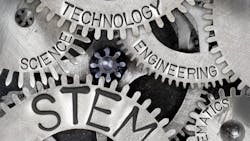Maintenance Mindset: Tech trends — AI-enhanced 3D printing, water electrolysis technology, and more
Welcome to Maintenance Mindset, our editors’ takes on things going on in the worlds of manufacturing and asset management that deserve some extra attention. This will appear regularly in the Member’s Only section of the site.
Where science and the economy intersect is often where we find businesses innovating, and the exploration of new technologies is often a collaboration between industry, government and academia. This science roundup covers news and research over the last month, connecting the government or university-led research and development (R&D) or workforce development that’s driving innovation in modern-day manufacturing.
This month’s column covers advances in:
- funding for sustainability technology to scale products focused on air quality, water scarcity, and energy security issues
- water electrolysis technology for green hydrogen production
- artificial intelligence (AI)-enhanced 3D metal printing technology
- environmental monitoring technology to measure the impacts of climate change
- scaling training opportunities for metalworking and manufacturing professionals at The Ohio State University
- advancing research and education in AI, automation and semiconductor manufacturing through an industry/academia partnership
- celebrating 10 years of research and development for advanced semiconductor chips
- internship opportunities at DOE national laboratories; don’t miss the Fall 2025 deadline: May 21.
8 startups receive funding to support sustainability technology in the U.S. Southwest
An Arizona State University-led, multi-institutional enterprise is funding eight companies in the U.S. Southwest focused on technology to solve air quality, water scarcity, and energy security issues. NSF Engines: Southwest Sustainability Innovation Engine (SWSIE), a university, industry and community collaboration funded by the U.S. National Science Foundation, announced its inaugural round of innovation grants to support companies transition from proof of concept to prototype to commercialization of a viable product.
SWSIE received more than 220 applications from 16 states. The eight winning companies are either based in or are piloting projects in Arizona, Nevada, and Utah:
- Purity ReSource wants to reduce the impact of the water-intensive semiconductor manufacturing industry with technology designed to extract purified water from existing semiconductor wet cleaning tools.
- Beyond Silicon wants to increase the efficiency limit of industry-standard silicon-based solar cells, which are rapidly approaching the theoretical limit of 27%. The company is developing a tandem perovskite-silicon solar cells, which have a projected efficiency of 38% and could deliver 30% more electricity than silicon solar panels.
- Silicon has also long been a foundation of semiconductors, but next-gen materials, such as silicon carbide and gallium nitride, are rapidly replacing the market, enabling electronics to withstand higher temperatures and voltage. However, they are costly, and the manufacturing process wastes upwards of 75% of these expensive materials. Crystal Sonic wants to use its patented Sonic Lift-off technology to reduce this waste. The technology harnesses acoustic energy to separate devices from substrates, so the material can be reused on another device.
- Wavr Technologies is using a patent-pending approach to atmospheric water harvesting to help with water issues along the Colorado River, which supplies Arizona, Nevada, and Utah. Born from NSF-funded research at the University of Nevada, Las Vegas, this water distillation process can be continuously operated and run on numerous energy sources — solar, traditional grid power, or waste heat.
- GlycoSurf is manufacturing natural, sugar-based chemicals for a variety of applications, including soaps, textiles, agriculture, and food emulsifiers. The grant will support the development of new, biodegradable extractants for mineral reclamation from industrial waste streams.
- Solid Carbon creates concrete admixtures made from organic waste streams to sequester biogenic carbon in concrete, and lowering the carbon footprint of concrete. The concrete industry as a whole produces approximately 8% of the world’s CO2 emissions. The funding will allow the company to explore how to upcycle organic waste, such as biochar from Arizona forests and transform it into durable, carbon-storing concrete.
- Carbon Utility is focused on capturing the emissions from high-polluting industries, such as chemical production, long-haul transportation, and materials manufacturing. Its modular, scalable direct air capture system removes carbon dioxide at a lower cost, with a small footprint.
- Battery supply chain gaps could slow widespread adoption of electrified transportation, and Storagenergy Technologies wants to fill the gap with energy-dense batteries. The startup is developing anode-free lithium metal batteries that pack more power, performance, and efficiency into a smaller footprint, targeting aviation applications.
Green hydrogen partnership focuses on sustainable technology using water
A partnership was launched by Michelin, CNRS, Grenoble Alpes University, Grenoble INP-UGA and Savoie Mont Blanc University. To address the challenge of large-scale hydrogen production, the research teams are designing next generation materials for green hydrogen production and low-carbon technology that will use water on an industrial scale. The water electrolysis technology, called Anion-Exchange Membrane Water Electrolyzer (AEMWE), will require the development of nano-catalyzers comprising metals that abound in the earth’s crust including nickel, and an anion exchange polymer membrane that is more environmentally compliant.
Johns Hopkins University researchers are making metal 3D printing faster and stronger
A research team from the Johns Hopkins Applied Physics Laboratory (APL) and the Whiting School of Engineering is using artificial intelligence to enhance production speed and material strength for advanced metal 3D printing, often used in aerospace and defense manufacturing. The team’s research, published in Additive Manufacturing, focuses on a widely used titanium alloy known for its high strength and low weight, expanding the capabilities for a method of 3D metal printing called laser powder bed fusion.
New approach to environmental monitoring and observing the impacts of climate change
Environmental monitoring is necessary for observing the impacts of climate change, and environmental remote sensing remains a challenge. In his doctoral thesis at the University of Oulu in Finland, Ankit Regmi introduces an innovative approach that utilizes the reflection of Global Navigation Satellite System (GNSS) signals from the Earth's surface. This enables the study of surface materials and properties, such as the measurement of sea level, sea ice thickness, and soil moisture.
The research uses a GNSS reflectometry system (GNSS-R), which uses a specially designed, antenna and commercial GNSS receivers to record both direct and reflected GNSS signals. Sea ice thickness is estimated by observing the total height difference between GNSS interferometric reflectometry results and sea level data from the Finnish Meteorological Institute. Changes in the GNSS signal passing through multi-layer ice are observed in the reflected GNSS parameter, enabling ice thickness measurement.
New manufacturing hub for metalworking to launch at Ohio State
Metallurgical Engineering Trades Apprenticeship & Learning (METAL) and The Ohio State University formed a new partnership to scale up industry-driven training opportunities for current and prospective metalworking and manufacturing professionals. Led by IACMI – The Composites Institute with funding from the Department of Defense’s Industrial Base Analysis and Sustainment Program, METAL strengthens and diversifies the U.S. metal manufacturing workforce, focusing on casting, forging, and plate rolling. Many new training opportunities and workshops will be held at Ohio State’s Center for Design and Manufacturing Excellence (CDME).
Through a blended approach of online and hands-on training, the METAL hub will teach fundamental skills in metalworking, heat treatment, and machining, as well as specialized topics like automation in the casting and forging industries.
Ohio State will provide educational resources and workforce development opportunities for students, industry professionals, and the broader community, while also fostering innovation and collaboration across higher education, industry, and K-12 programs.
Partnership between Emerson and The University of Texas at Austin to support advanced research for automation
A new partnership between Emerson and The University of Texas at Austin will support advanced research into artificial intelligence, automation, energy, semiconductors and other areas. The three-year agreement includes research lab upgrades at UT facilities and contributions to help launch the new Semiconductor Science and Engineering master’s degree program in partnership with the Texas Institute for Electronics (TIE). UT will become a core research partner for Emerson as it delves further into semiconductors, AI, energy, and other areas in the future.
The total value of the agreement is $8.5 million. Emerson has now contributed more than $20 million to UT, primarily to the Cockrell School of Engineering and its McKetta Department of Chemical Engineering, both from the St. Louis-based company and its recent acquisition of Austin-based National Instruments, now operating as Emerson’s test and measurement business.
Emerson will contribute technology and equipment to modernize the Montopolis Research Center to advance semiconductor research, as well as funds to support the first three cohorts of students enrolled in the new 18-month Semiconductor Science and Engineering master’s program, starting fall of 2025.
Emerson will also make large investments in UT science facilities focused on AI-enabled automation research in process optimization, control, and safety, chemical engineering, and petroleum and geosystems engineering.
PowerAmerica celebrates 10 years supporting advanced semiconductor technology
More than 10 years ago, Congress enacted the Revitalizing American Manufacturing and Innovation Act, establishing Manufacturing USA. PowerAmerica, a Manufacturing USA institute that has served as a catalyst for wide bandgap (WBG) semiconductor chips and power electronic systems, is also celebrating its 10th anniversary this year, established January 2015.
The institute works with public and private partners to develop WBG technologies, including power silicon carbide (SiC) and gallium nitride (GaN) semiconductors, which are more powerful and use less energy than traditional silicon-based designs in an array of applications, such as electric vehicles, grid and renewables, industrial motor systems, consumer electronics, and data centers.
SiC is suited for high-power and high-voltage uses and can tolerate high temperatures, making it ideal for demanding environments. GaN devices, in contrast, excel in speed and compactness.
DOE opens applications for Fall 2025 internship programs
The Department of Energy (DOE) Office of Science has announced that applications are being accepted for the Fall 2015 term for two undergraduate internship programs through the Science Undergraduate Laboratory Internships (SULI) program and the Community College Internships (CCI) program. The application deadline is May 21, 2025, at 5:00 p.m. EDT.
Students and recent graduates can discover science and technology careers at the DOE national laboratories, working directly with national laboratory scientists, engineers, and technical professionals on DOE research and technical projects. SULI is open to full-time students attending either 2-or 4-year colleges and universities or recent graduates within two years of receiving their bachelor’s degree or associate degree, while CCI is exclusively for community college students. Both programs are stipend-based and offered three times annually in fall, spring, and summer terms.
SULI and CCI programs are managed by the Office of Workforce Development for Teachers and Scientists (WDTS) in the Office of Science.
About the Author

Anna Townshend
managing editor
Anna Townshend has been a journalist and editor for almost 20 years. She joined Control Design and Plant Services as managing editor in June 2020. Previously, for more than 10 years, she was the editor of Marina Dock Age and International Dredging Review. In addition to writing and editing thousands of articles in her career, she has been an active speaker on industry panels and presentations, as well as host for the Tool Belt and Control Intelligence podcasts. Email her at [email protected].
